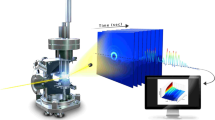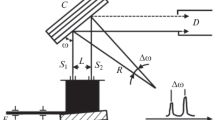Abstract
We have assessed the informativeness of X-ray diffraction patterns in the form of a halo, characteristic of metallic alloys prepared by liquid quenching (melt spinning) (using an Fe78P20Si2 alloy as an example) and oxide films grown on unheated substrates by ion beam sputtering of targets with an appropriate composition (LiNbO3 and Ca10(PO4)6(OH)2). Simulation results for X-ray diffraction patterns of expected crystalline phases with allowance for the size effect in diffraction demonstrate that a model halo agrees well with the halos observed in X-ray diffraction patterns of the samples under study. Observed correlations lead us to conclude that, inherent in rather large crystals, coherence of elastically scattered waves is lost in the structures considered here because of the random mutual orientation of crystalline nuclei of the corresponding phases with ultimately small dimensions. For this reason, translational symmetry, limited by the ultimately small dimensions of mutually misoriented crystallites, is the most transparent characteristic of the nature of such (quasi-amorphous) structures for systems with strong interatomic bonding.



Similar content being viewed by others
Notes
Russian Foundation for Basic Research, grant no. 17-03-01140 A.
Russian Foundation for Basic Research, grant no. 18-29-11062.
One example of such summation of extremely small volumes of coherently scattering space is epitaxial films in a discrete nucleation step.
REFERENCES
Bol’shaya sovetskaya entsiklopediya (Big Soviet Encyclopedia), Moscow: Bol’shaya Sovetskaya Entsiklopediya, 1952, 2nd ed., vol. 2, p. 292.
Hannay, N.B., Solid-State Chemistry, Englewood Cliffs: Prentice-Hall, 1967.
Ormont, B.F., Vvedenie v fizicheskuyu khimiyu i kristallokhimiyu poluprovodnikov: uchebnoe posobie (Introduction to the Physical Chemistry and Crystal Chemistry of Semiconductors: A Learning Guide), Moscow: Vysshaya Shkola, 1968.
Karapet’yants, M.Kh. and Drakin, S.I., Stroenie veshchestva (Structure of Matter), Moscow: Vysshaya Shkola, 1970, 2nd ed.
Amorphous Metallic Alloys, Luborsky, F.E., Ed., Boston: Butterworths, 1983.
Aleinikova, K.B., Zinchenko, E.N., and Zmeikin, A.A., Atomic Structure of the Amorphous Metallic Alloy Al83.5Ni9.5Si1.4La5.6, Glass Phys. Chem., 2018, vol. 44, no. 4, pp. 307–313.
Skryshevskii, A.F., Strukturnyi analiz zhidkostei i amorfnykh tel (Structural Analysis of Liquids and Amorphous Solids), Moscow: Vysshaya Shkola, 1980, 2nd ed.
Alder, B.J. and Weinwright, T.E., Phase transition for a hard sphere system, J. Chem. Phys., 1957, vol. 27, pp. 1208–1209.
Barker, J.A., Hoare, M.R., and Finney, J.L., Relaxation of the Bernal model, Nature, 1975, vol. 257, pp. 120–122.
Maeda, K. and Takeuchi, S., A simple computer modeling of metallic amorphous structure, J. Phys. F: Met. Phys., 1978, vol. 8, no. 12, pp. 283–288.
Evteev, A.V. and Kosilov, A.T., General trends in structure self-organization of Fe83M17 (M = C, B, P) metallic glasses), Vestn. Voronezhsk. Gos. Tekh. Univ.,Ser. Materialoved., 1999, no. 1.5, pp. 53–60.
Sheng, H.W., Luo, W.K., Alamgir, F.M., et al., Atomic packing and short-to-medium range order in metallic glasses, Nature, 2006, vol. 439, pp. 419–425.
Hui, X., Gao, R., and Chen, G., Short-to-medium range order in Mg65Cu25Y10 metallic glass, Phys. Lett. A, 2008, vol. 372, no. 17, pp. 3078–3084.
Wang, C.C. and Wong, C.H., Short-to-medium range order of Al–Mg metallic glasses studied by molecular dynamics simulations, J. Alloys Compd., 2011, vol. 509, no. 42, pp. 10222–10229.
Qi, L., Liu, M., and Zhang, S.L., Atomic packing and short-to-medium range order evolution of Zr–Pd metallic glass, Chin. Sci. Bull., 2011, vol. 56, no. 36, pp. 3908–3911.
Sha, Z.D., Zhang, Y.W., Feng, Y.P., and Li, Y., Molecular dynamics studies of short to medium range order in Cu64Zr36 metallic glass, J. Alloys Compd., 2011, vol. 509, no. 33, pp. 8319–8322.
Zhang, Y., Mattern, N., and Liang, T.X., Atomic packing short-to-medium range order in a U–Fe metallic glass, Appl. Phys. Lett., 2012, vol. 101, no. 2, paper 021909.
Heidenreich, R.D., Fundamentals of Transmission Electron Microscopy, New York: Interscience, 1964. Translated under the title Osnovy prosvechivayushchei elektronnoi mikroskopii, Moscow: Mir, 1966, p. 471.
Aleynikova, K.B. and Zinchenko, E.N., Fragment model as a phase analysis method for diffraction amorphous materials, Russ. J. Struct. Chem., 2009, vol. 50, no. 7, pp. 93–99.
Abrosimova, G.E., Structural evolution of amorphous alloys, Usp. Fiz. Nauk, 2011, vol. 181, pp. 1265–1281.
Glezer, A.M. and Shurygina, N.A., Amorfno-nanokristallicheskie splavy (Amorphous–Nanocrystalline Alloys), Moscow: Fizmatlit, 2013.
Vavilova, V.V., Ievlev, V.M., Kannykin, S.V., Il’inova, T.N., Zabolotnyi, V.T., Korneev, V.P., Anosova, M.O., and Baldokhin, Yu.V., Nanocrystallization and change in the properties of an Fe80.2P17.1Mo2.7 amorphous alloy during heat or photon treatment, Russ. Metall. (Engl. Transl.), 2014, no. 6, pp. 888–894.
Inoue, A., Yamamoto, M., Kimura, H.M., and Masumoto, T., Ductile aluminum-base amorphous alloys with two separate phases, J. Mater. Sci., 1987, vol. 6, pp. 194–199.
Yavari, A.R., On the structure of metallic glasses with double diffraction halos, Acta Metall., 1988, vol. 36, pp. 1863–1869.
Vainshtein, B.K., Strukturnaya elektronografiya (Structural Analysis by Electron Diffraction), Moscow: Akad. Nauk SSSR, 1956.
Hirsch, P.B., Howie, A., Nicholson, R.B., Pashley, D.W., and Whelan, M.J., Electron Microscopy of Thin Crystals, London: Butterworths, 1965.
Yatsenko, D.A. and Tsybulya, S.V., DIANNA (diffraction analysis of nanopowders): software for structural analysis of ultradisperse systems by X-ray methods, Bull. Russ. Acad. Sci.: Phys., 2012, vol, 76, no. 3, pp. 382–384.
Rietveld, H., A profile refinement method for nuclear and magnetic structures, J. Appl. Crystallogr., 1969, vol. 2, pp. 65–71.
Degen, T., Sadki, M., Bron, E., König, U., and Nénert, G., The HighScore suite, Powder Diffr., 2014, vol. 29, no. 2, pp. 13–18.
Cheary, R.W., Coelho, A.A., and Cline, J.P., Fundamental parameters line profile fitting in laboratory diffractometers, J. Res. Natl. Inst. Stand. Technol., 2004, vol. 109, pp. 1–25.
https://materials.springer.com/
Antonova, M.S., Belonogov, E.K., Boryak, A.V., Vavilova, V.V., Ievlev, V.M., Kannykin, S.V., and Palii, N.A., Photoactivated nanocrystallization and hardness of Fe78P20Si2 alloy, Inorg. Mater., 2015, vol. 51, no. 3, pp. 283–287.
Vavilova, V.V., Kovneristyi, Yu.K., and Palii, N.A., Correlation between the short-range structure of amorphous alloys of the Fe–P–Si system and the crystal structure of the base metal (Fe), Dokl. Phys. Chem., 2000, vol. 372, nos. 4–6, pp. 79–81.
ICDD PDF-2 00-054-0022.
Harper, R.A. and Posner, A.S., Radial distribution study of non-crystalline tricalcium phosphate, Mater. Res. Bull., 1970, vol. 5, no. 2, pp. 129–136.
Onuma, K. and Ito, A., Cluster growth model for hydroxyapatite, Chem. Mater., 1998, vol. 10, no. 11, pp. 3346–3351.
Tadic, D., Veresov, A., Putlayev, V., and Epple, M., In-vitro preparation of nanocrystalline calcium phosphates as bone substitution materials in surgery, Mat.-Wiss. Werkstofftech., 2003, vol. 34, no. 12, pp. 1048–1051.
Somrani, S., Rey, C., and Jemal, M., Thermal evolution of amorphous tricalcium phosphate, J. Mater. Chem., 2003, vol. 13, pp. 888–892.
Budai, J., Gaudig, W., and Sass, S.L., The measurement of grain boundary thickness using X-ray diffraction techniques, J. Mater. Chem. A, 1979, vol. 40, no. 6, pp. 757–767.
Carter, C.B., Donald, A.M., and Sass, S.L., The study of grain boundary thickness using electron diffraction techniques, J. Mater. Chem. A, 1980, vol. 41, no. 4, pp. 467–475.
Hagege, S., Carter, C.B., and Cosandey, F., The variation of grain boundary structural width with misorientation angle and boundary plane, J. Mater. Chem. A, 1982, vol. 45, no. 4, pp. 723–740.
Lamarre, P. and Sass, S.L., Detection of the expansion at large angle 〈001〉 twist boundary using electron diffraction, Scr. Metall. Mater., 1983, vol. 17, no. 9, pp. 1141–1146.
Burova, S.V., Faceting and structure of grain boundaries and interfaces in thin films, Extended Abstract of Cand. Sci. (Phys.–Math.) Dissertation, Voronezh: Voronezh Pedagogical Inst., 1985.
ICDD PDF-2 00-043-1172.
ACKNOWLEDGMENTS
In this research, we used equipment at the Shared Research Facilities Center, Voronezh State University.
Funding
This work was supported by the Russian Foundation for Basic Research, grant nos. 17-03-01140 A (investigation of Fe78P20Si2 amorphous alloys) and 18-29-11062 (investigation of LiNbO3 films).
Author information
Authors and Affiliations
Corresponding author
Additional information
Translated by O. Tsarev
Rights and permissions
About this article
Cite this article
Ievlev, V.M., Kannykin, S.V., Kostyuchenko, A.V. et al. On the Informativeness of X-Ray Diffraction Patterns in the Form of a Halo. Inorg Mater 56, 859–866 (2020). https://doi.org/10.1134/S0020168520080051
Received:
Revised:
Accepted:
Published:
Issue Date:
DOI: https://doi.org/10.1134/S0020168520080051




